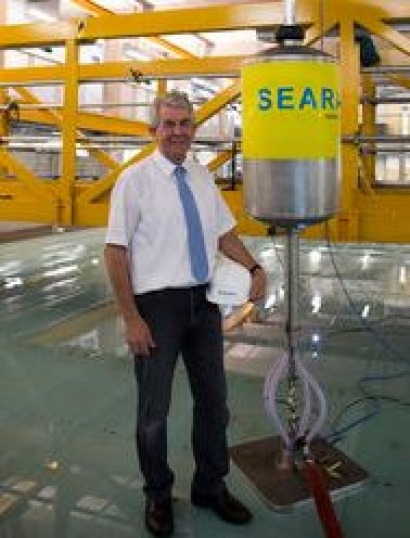
The device was invented by Alvin Smith and is designed to overcome two of the biggest hurdles facing the deployment of renewable energy – cost and variable output.
Ecotricity and the Searaser team have spent 18 months optimising the design of the device and modelling outputs in real world conditions around the British coastline, with the assistance of DNV GL Group (formerly Garrad Hasan).
“We’ve put Searaser through the most extreme testing regime at Plymouth’s CoastLAB and it’s passed every challenge” said Mr Smith, adding that the determining factor in making wave power efficient, and therefore cost-effective, was resilience. ““We’ve just completed wave tank testing at Plymouth University to validate the extensive computer modelling we’ve been undertaking.”
Searaser differs from other marine energy technologies by using the motion of the ocean swell to pump high pressure seawater ashore where it is used to generate electricity. The device does not generate electricity itself out at sea.
The motion of the waves drives a piston between two buoys, one of them on the surface of the water and the other suspended underwater and tethered to a weight on the seabed. As waves move past, the surface buoy moves the piston up-and-down, pumping volumes of pressurised seawater through a pipe to an onshore hydropower turbine to produce electricity.
These ‘Seamills’ could be used to pump seawater into coastal reservoirs, from where it can be released at any time of the day or night, to make renewable electricity on demand.
“Our vision is for Britain’s electricity needs to be met entirely from our big three renewable energy sources – the Wind, the Sun and the Sea” said Ecotricity founder Dale Vince. “Out of these three energy sources, generating electricity from the sea is by far the most difficult due to the hostile ocean environment – it’s also the least advanced of the three technologies but it has enormous potential. We believe these Seamills have the potential to produce a significant amount of the electricity that Britain needs, from a clean indigenous source and in a more controllable manner than currently possible.”
Ecotricity hopes to have a full scale prototype in the ocean over the next 12 months and to be producing electricity from the first commercial arrays of ‘Seamills’ with a few years. The device could transform the energy market around the world as well as generating green jobs in the British economy.
For additional information:
(Picture by Megan Walker)

